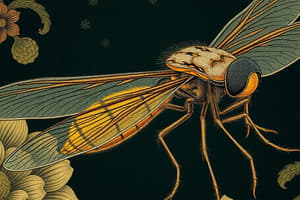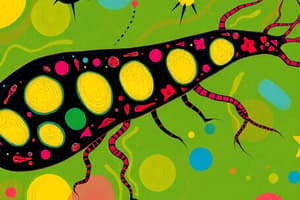Podcast
Questions and Answers
What is the significance of isolating genetic variants of Trypanosoma brucei?
What is the significance of isolating genetic variants of Trypanosoma brucei?
- It allows for the identification of more effective pesticide treatments.
- It reveals the morphological differences among the subspecies.
- It helps in developing strategies for pathogen control and disease treatment. (correct)
- It assists in the classification of different species of Trypanosoma.
Which of the following methods is commonly used to reveal intraspecific diversity in parasites?
Which of the following methods is commonly used to reveal intraspecific diversity in parasites?
- Microsatellite analysis (correct)
- DNA sequencing
- Protein expression profiling
- Microscopy analysis
Which subspecies of Trypanosoma brucei is responsible for causing animal trypanosomiasis?
Which subspecies of Trypanosoma brucei is responsible for causing animal trypanosomiasis?
- Trypanosoma brucei brucei (correct)
- Trypanosoma brucei gambiense
- Trypanosoma brucei rhodesiense
- Trypanosoma brucei subgenus
Which statement accurately describes the vectors and hosts of the Trypanosoma brucei subspecies?
Which statement accurately describes the vectors and hosts of the Trypanosoma brucei subspecies?
What is the primary characteristic that differentiates Trypanosoma brucei gambiense from Trypanosoma brucei rhodesiense?
What is the primary characteristic that differentiates Trypanosoma brucei gambiense from Trypanosoma brucei rhodesiense?
How does intraspecific diversity benefit the study of Trypanosoma brucei?
How does intraspecific diversity benefit the study of Trypanosoma brucei?
In the context of Trypanosoma brucei, what is a strain?
In the context of Trypanosoma brucei, what is a strain?
What type of disease is caused by Trypanosoma brucei rhodesiense?
What type of disease is caused by Trypanosoma brucei rhodesiense?
What is the primary reason for the taxonomic reclassification of Orientobilharzia to Schistosoma?
What is the primary reason for the taxonomic reclassification of Orientobilharzia to Schistosoma?
Which of the following best describes 'isolates' in the context of parasitology?
Which of the following best describes 'isolates' in the context of parasitology?
What best defines the challenge faced by the taxonomy of the Family Capsalidae?
What best defines the challenge faced by the taxonomy of the Family Capsalidae?
In the study of intraspecific diversity, what distinguishes a subspecies from a regular population?
In the study of intraspecific diversity, what distinguishes a subspecies from a regular population?
In immunohistochemistry, which of the following is critical for visualizing specific antigens within tissues?
In immunohistochemistry, which of the following is critical for visualizing specific antigens within tissues?
Which method is least effective in distinguishing between different subspecies of Trypanosoma brucei?
Which method is least effective in distinguishing between different subspecies of Trypanosoma brucei?
What is the major factor that complicates the taxonomy of trematodes like Schistosoma?
What is the major factor that complicates the taxonomy of trematodes like Schistosoma?
Which challenge is primarily addressed by recognizing synapomorphies in parasite taxonomy?
Which challenge is primarily addressed by recognizing synapomorphies in parasite taxonomy?
What is the significance of homoplasy in parasite morphology?
What is the significance of homoplasy in parasite morphology?
Which characteristic is NOT typically associated with intraspecific variations?
Which characteristic is NOT typically associated with intraspecific variations?
What does the term 'heirloom parasite' refer to in the context of Pediculus humanus?
What does the term 'heirloom parasite' refer to in the context of Pediculus humanus?
Which hypothesis better explains the divergence time between Pthirus pubis and Pthirus gorillae?
Which hypothesis better explains the divergence time between Pthirus pubis and Pthirus gorillae?
How did humans acquire two different species of lice according to the phylogenetic analysis?
How did humans acquire two different species of lice according to the phylogenetic analysis?
Which of the following statements best describes the relationship of Schistosoma mansoni to its environment?
Which of the following statements best describes the relationship of Schistosoma mansoni to its environment?
What distinguishes Pthirus pubis from Pediculus humanus in terms of evolution?
What distinguishes Pthirus pubis from Pediculus humanus in terms of evolution?
Which statement best describes the biological species concept (BSC) as it applies to asexual parasites?
Which statement best describes the biological species concept (BSC) as it applies to asexual parasites?
What is the primary issue with using the biological species concept for classifying protozoan parasites such as Entamoeba?
What is the primary issue with using the biological species concept for classifying protozoan parasites such as Entamoeba?
Which of the following is NOT a recognized issue with the biological species concept regarding parasitic relationships?
Which of the following is NOT a recognized issue with the biological species concept regarding parasitic relationships?
In the context of hybridization in parasites, which of the following pairs exemplifies this phenomenon?
In the context of hybridization in parasites, which of the following pairs exemplifies this phenomenon?
Which method is commonly used for identifying cryptic gamete exchanges in Trypanosoma species?
Which method is commonly used for identifying cryptic gamete exchanges in Trypanosoma species?
What significance does the life cycle of Schistosoma hematobium have in the study of parasitism?
What significance does the life cycle of Schistosoma hematobium have in the study of parasitism?
Which of the following reflects the challenges surrounding the classification of metazoan parasites?
Which of the following reflects the challenges surrounding the classification of metazoan parasites?
Which protozoan parasite is known to have distinct clonal lines with rare sexual reproduction?
Which protozoan parasite is known to have distinct clonal lines with rare sexual reproduction?
What best describes horizontal gene transfer in the context of parasitic organisms?
What best describes horizontal gene transfer in the context of parasitic organisms?
What does a lack of effective gene flow signify for parasite classification?
What does a lack of effective gene flow signify for parasite classification?
What mechanism was identified as a likely method for Schistosoma mansoni introduction to the New World?
What mechanism was identified as a likely method for Schistosoma mansoni introduction to the New World?
Which intermediate host is primarily associated with the life cycle of Schistosoma mansoni?
Which intermediate host is primarily associated with the life cycle of Schistosoma mansoni?
What is the main way that adult Schistosoma mansoni reproduce in their human host?
What is the main way that adult Schistosoma mansoni reproduce in their human host?
What role do miracidia play in the life cycle of Schistosoma mansoni?
What role do miracidia play in the life cycle of Schistosoma mansoni?
Which technique is utilized for cataloguing unknown parasite species based on mitochondrial DNA sequences?
Which technique is utilized for cataloguing unknown parasite species based on mitochondrial DNA sequences?
What does the colonization of Biomphalaria species in Africa suggest about the evolutionary history of Schistosoma mansoni?
What does the colonization of Biomphalaria species in Africa suggest about the evolutionary history of Schistosoma mansoni?
What type of data suggests the establishment of schistosomiasis in the New World occurred in the 1600s?
What type of data suggests the establishment of schistosomiasis in the New World occurred in the 1600s?
Which characteristic is key in identifying cryptic species through DNA barcoding?
Which characteristic is key in identifying cryptic species through DNA barcoding?
What significant event in the 16th century influenced the distribution of Schistosoma mansoni?
What significant event in the 16th century influenced the distribution of Schistosoma mansoni?
What type of ecological interaction is exhibited between the Biomphalaria snails and Schistosoma mansoni?
What type of ecological interaction is exhibited between the Biomphalaria snails and Schistosoma mansoni?
Flashcards are hidden until you start studying
Study Notes
Trypanosoma brucei Subspecies
- Three subspecies of Trypanosoma brucei: T brucei brucei, T.brucei gambiense, and T.brucei rhodesiense are morphologically indistinguishable but have different vectors and hosts.
- Trypanosoma brucei brucei causes Nagana or animal trypanosomiasis.
- Trypanosoma brucei gambiense causes West African or Gambian Sleeping Sickness in humans.
- Trypanosoma brucei rhodesiense causes East African or Rhodesian Sleeping Sickness in humans.
- It is important to distinguish between subspecies of T.brucei because they cause different diseases in humans.
Intraspecific Variation
- Intraspecific diversity can be revealed using microsatellite analysis → typically uses short tandem repeat (STR) sequences (~2-6 bp long) from non-coding regions of the genome.
- Isolate - a sample of a parasite species taken from a host at a specific point in time (e.g.Plasmodium falciparum 3D7 isolate)
- Subspecies - a population of organisms within a species that occupy a particular geographic region and are genetically distinguishable from other populations of the same species. They can interbreed with other subspecies populations where their ranges overlap but normally do not (e.g.mansoni is native to Africa but molecular & historical data suggest that schistosomiasis was not present in the New World until the 1600s → how did the parasite get to the New World?
Improving Parasite Taxonomy
- Homoplasy - convergent evolution in morphological structures e.g.ectoparasitic flatworms of the Family Capsalidae → 4 members of the subfamily do not form a monophyletic clade when analyzed at the molecular level
- The taxonomic goal is to identify synapomorphies→ shared, evolutionarily- derived character traits that show patterns of common descent.
- Originally, Orientobilharzia & Schistosoma were distinguished by the number of testes and placed in different clades…….….however, after molecular analysis, O.turkestanicum is now called Schistosoma turkestanicum and is placed in the same clade.
Schistosoma mansoni in Africa and South America
- Adult worms reproduce in the veins draining the intestine of humans → eggs excreted with host feces into water → miracidia larvae → snail intermediate host (Genus: Biomphalaria) → cercariae larvae exit snail → penetrates skin of human host
- Ancestral Biomphalaria species are thought to have originated in South America
- 3 possible scenarios that may explain how the South American freshwater snail genus Biomphalaria became established in Africa & then became an intermediate host of Schistosoma mansoni
- Species of Biomphalaria which evolved in Africa & are hosts of Schistosoma mansoni
- The trans-Atlantic slave trade in the 16th century introduced schistosomiasis from Africa to the New World
DNA Barcoding
- DNA barcoding- identifies unknown biological specimens, typically using “signature” mitochondrial DNA sequences [e.g.cytochrome c oxidase I (COI)] for animals and then comparing to known sequences in molecular sequence databases
- Useful for cataloguing cryptic species (e.g., The Diversity of Parasite Species).
Biological Species Concept (BSC)
- A group of individuals with similar properties that interbreed with each other or could possibly breed under natural conditions and are reproductively isolated from other such groups
- BSC emphasizes absence of gene flow
- Applicable to many parasite species but there are some problems associated with its definition.
Problems with BSC in parasites
- Asexual species→ reproduction by binary fission; some protozoan parasites are not known to undergo sexual reproduction (e.g.Entamoeba) or rarely undergo sexual reproduction (e.g.Giardia → distinct clonal lines)
- Horizontal (lateral) gene transfer → one organism acquiring genetic information from another organism without being the offspring of that organism (e.g some parasitic nematodes & bacteria)
- Cryptic exchange of gametes- e.g.Trypanosoma & Leishmania
- Hybridizing species- the interbreeding of closely related species (e.g.Fasciola hepatica x Fasciola gigantica, 3 Schistosoma hematobium x Schistosoma bovis)
Humans and Lice
- Humans are parasitized by 2 different genera of blood- sucking lice: Pediculus humanus (body louse) and Pthirus pubis (pubic louse)
- Chimps and gorillas each have only 1 species of louse, Pediculus schaeffi and Pthirus gorillae, respectively
- Time of divergence from the common ancestor of Pediculus and Pthirus, and between humans and primates was estimated from DNA sequencing
- Generate hypotheses using phylogenetic trees as to how humans acquired 2 louse species
Reconstructing Historical Biogeography of Parasites
- How geology, ecology, climate or human activities influence the distribution of parasites
- Schistosoma mansoni is a trematode which causes schistosomiasis in Africa as well as South America
- S. mansoni is thought to have originated in Africa and spread to South America via the Trans-Atlantic slave trade.
Studying That Suits You
Use AI to generate personalized quizzes and flashcards to suit your learning preferences.




